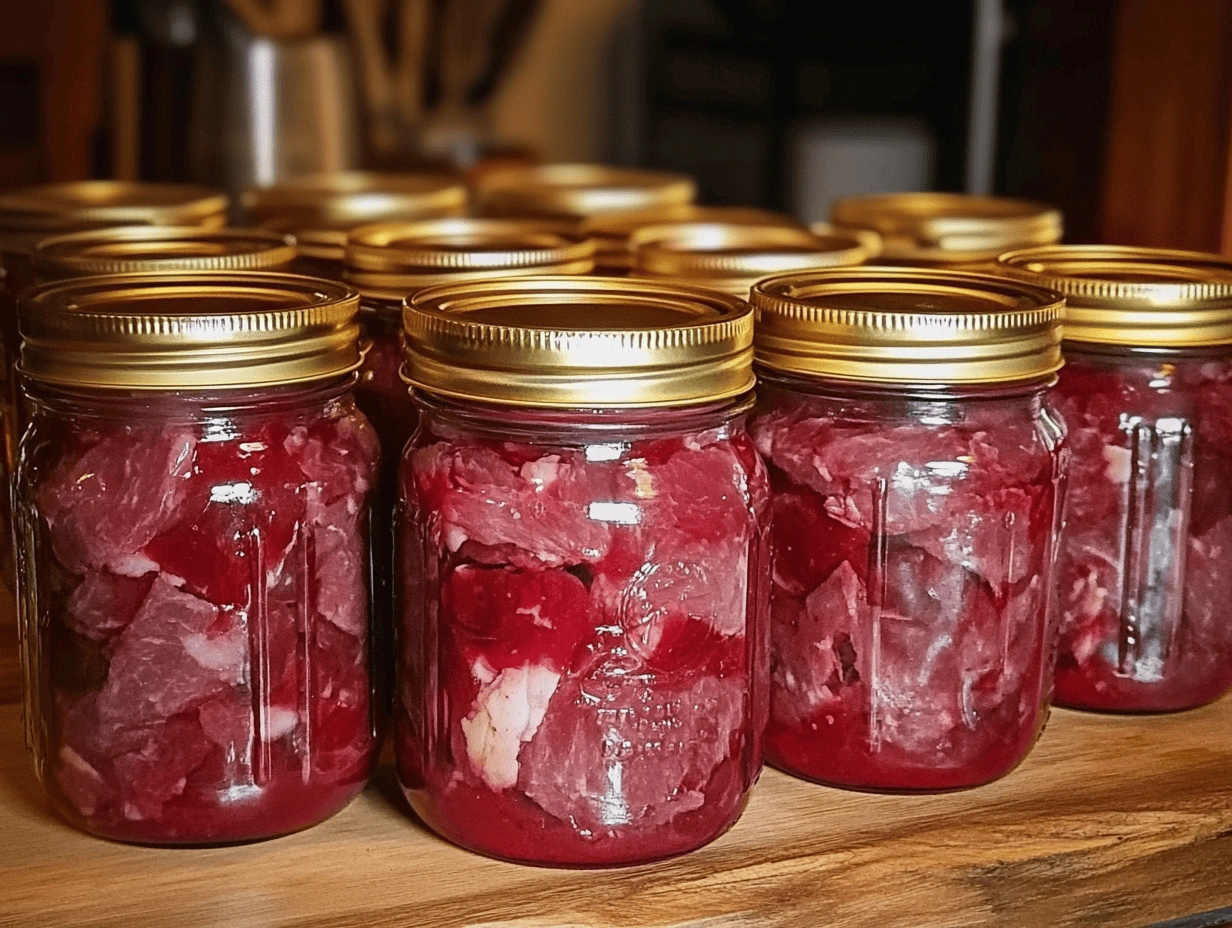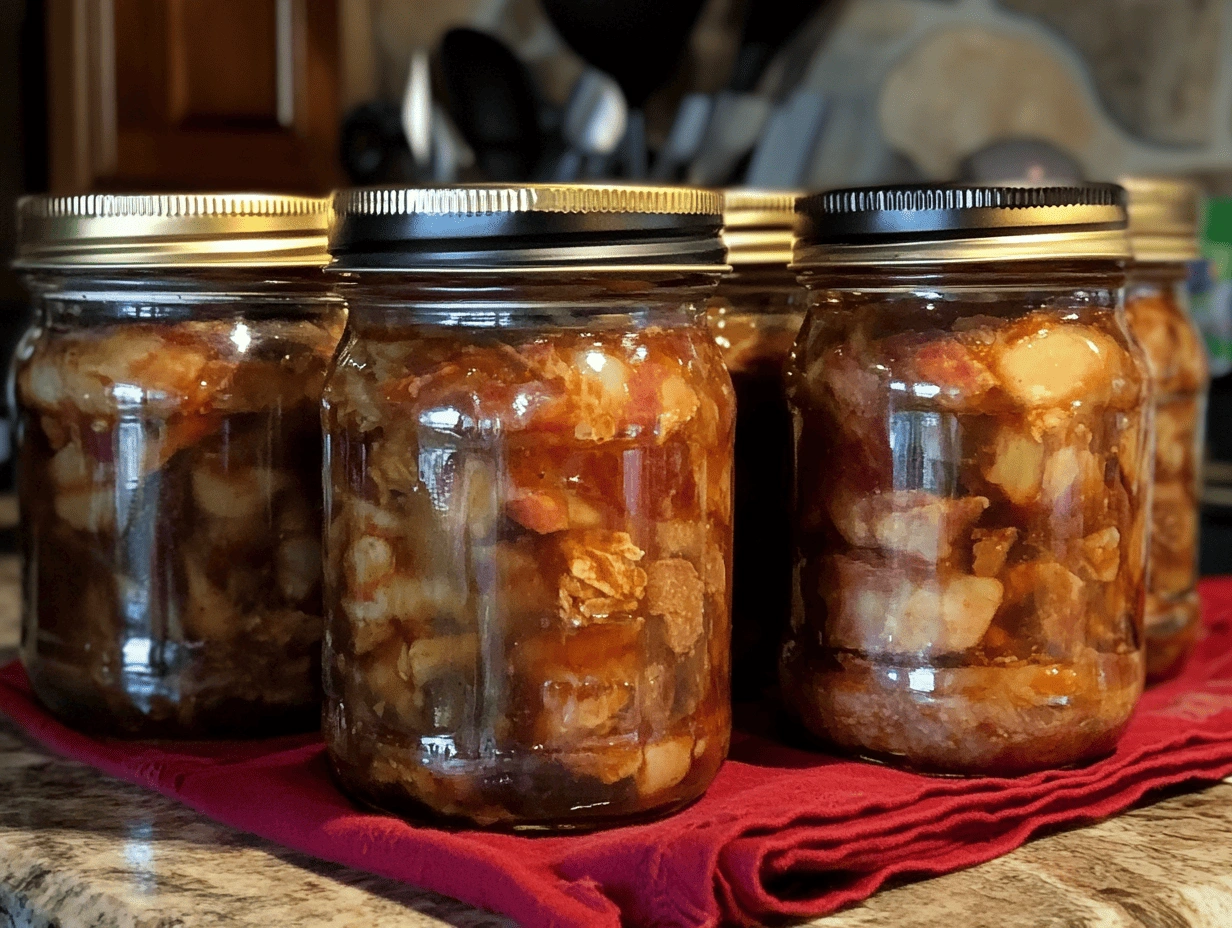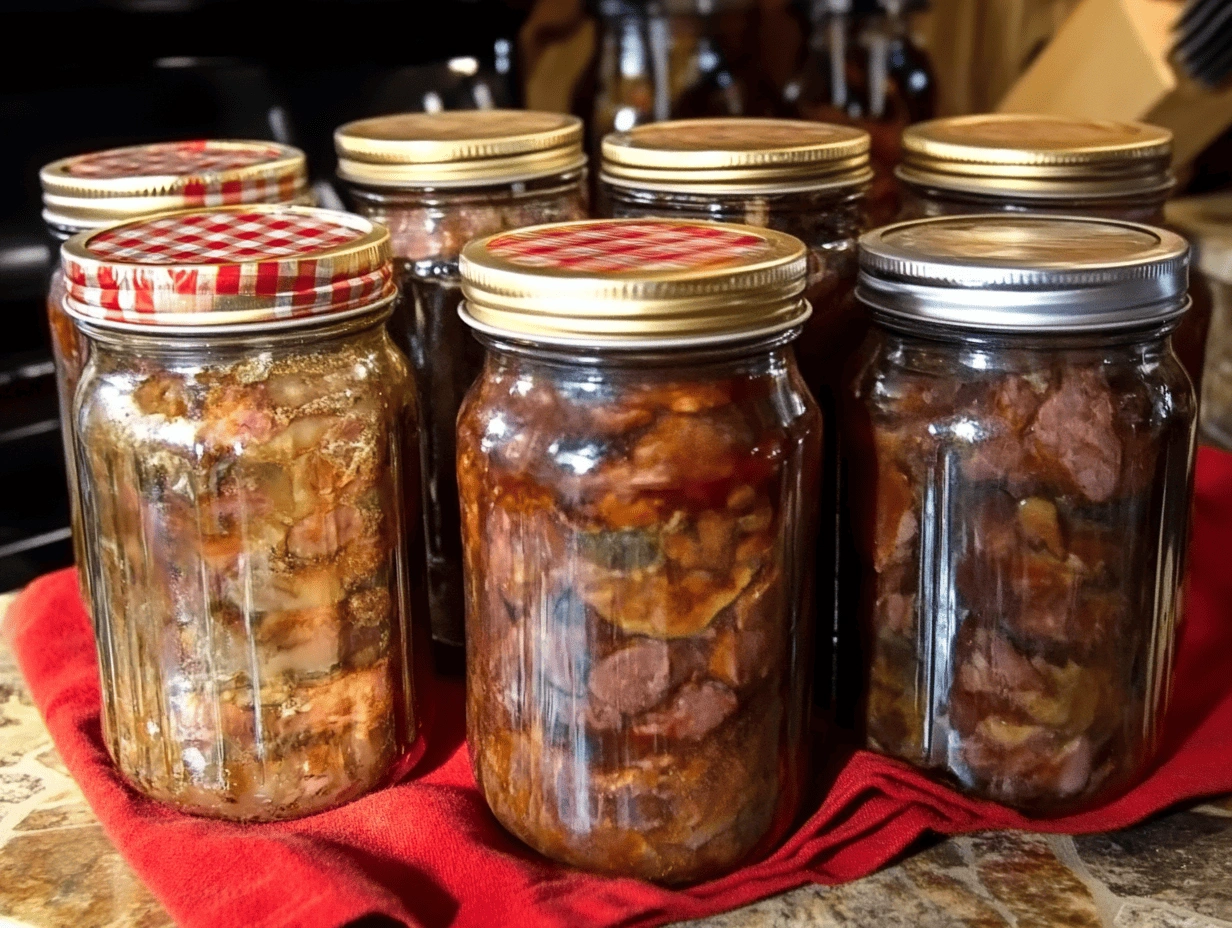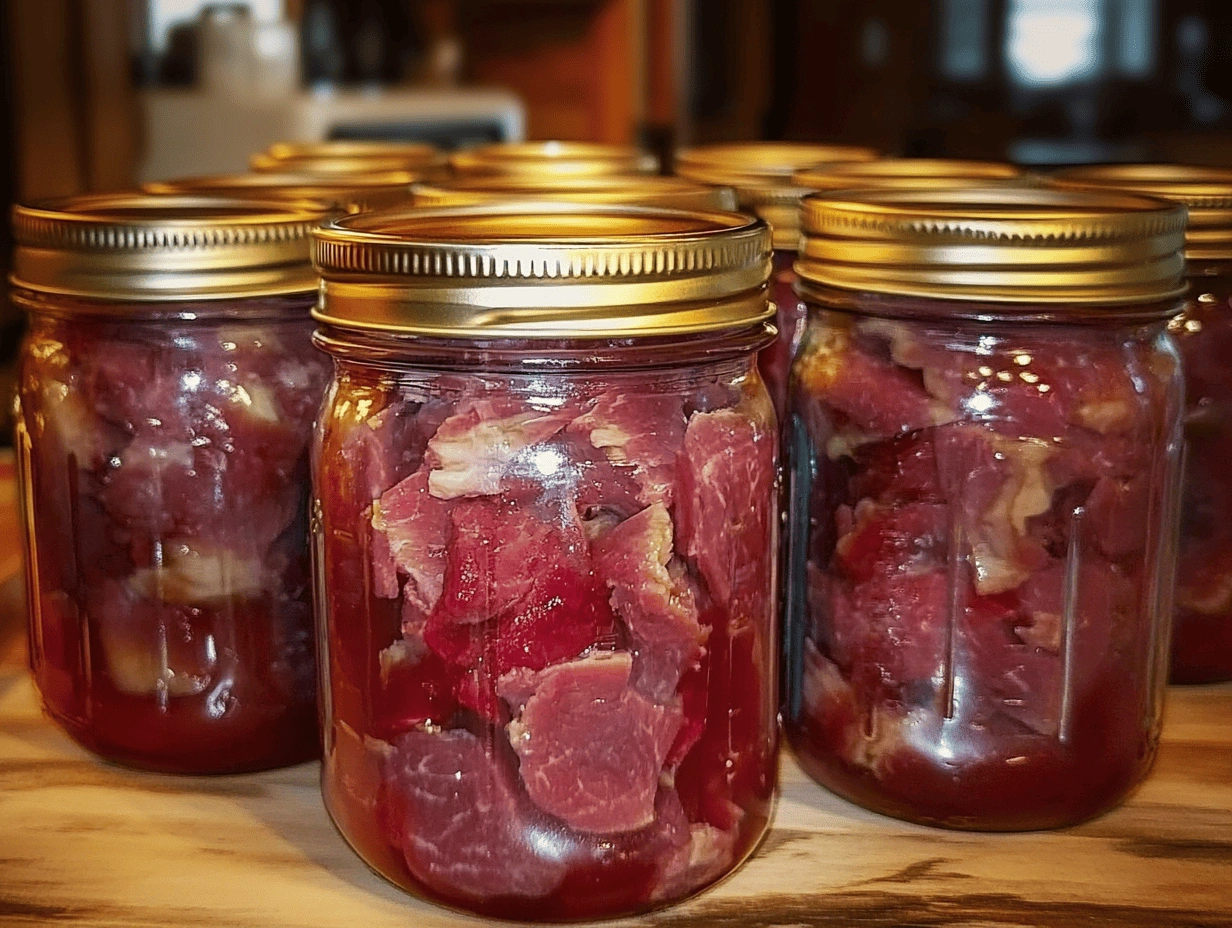Introduction to Pickling Meat: Understanding the Basics
What is Pickling Meat?
Pickling meat is an age-old preservation method that involves soaking meat in a salty or acidic solution to prevent bacterial growth. This process significantly extends the meat’s shelf life. Historically, it was crucial for survival before refrigeration, especially for sailors on long voyages or families preparing for harsh winters.
Beyond preservation, pickling meat enhances flavor. A great example is pickled sausage, which combines tangy and savory notes, making it a favorite for many. If you’re curious to try it yourself, this Easy Pickled Sausage Recipe offers a great starting point.
What Are the Main Methods of Pickling Meat?
There are two primary ways to pickle meat:
- Brining
In brining, meat is submerged in a saltwater solution. The salt prevents bacterial growth and enhances the meat with a savory flavor. Brining is ideal for those who prefer milder-tasting pickled meats. - Vinegar-Based Pickling
This method involves soaking meat in a vinegar and water mixture, often spiced for extra flavor. The acidity in the vinegar not only preserves the meat but also creates a tangy, bold taste
While brining offers a milder flavor, vinegar-based pickling is perfect for creating tangy, bold tastes. Additionally, experimenting with recipes like Homemade Pickled Sausage can help you discover new flavor profiles.
Why Should You Pickle Meat?
Pickling meat offers several advantages. First, it enhances the flavor by infusing the meat with salty or tangy notes. This flavor improvement is a key reason why many enjoy pickled meat. Second, it significantly extends the shelf life, making it a reliable food source for months.
A common question is, how long does pickled meat last? Properly pickled meat can stay fresh for weeks or even months, depending on the method used and how it is stored. By reducing food waste, pickling is also a sustainable and economical option, ideal for outdoor adventures or emergencies where refrigeration isn’t available.
How Long Does Pickled Meat Last?

The shelf life of pickled meat is a major consideration for those using this preservation method. So, how long does pickled meat last? When stored correctly, brined meat can remain fresh for several weeks in the refrigerator. Vinegar-based pickled meat, on the other hand, can last for months.
If properly canned or vacuum-sealed, the shelf life can be extended even further. To ensure safety, always store pickled meat in clean, airtight containers and check for any signs of spoilage, like changes in color, texture, or smell. Knowing how long pickled meat lasts helps you plan your storage and enjoy this flavorful preservation method safely.
Factors That Affect Shelf Life
Preparation quality is equally important. Using clean jars, ensuring airtight seals, and following proper procedures can significantly reduce spoilage risks. For example, when pickling sausages, attention to detail is crucial. A comprehensive guide on Pickled Sausage Shelf Life offers clear steps to maintain safety and freshness.
How Long Does Pickled Meat Typically Last?
The answer to How Long Does Pickled Meat Last depends on how it is stored. Here are the most common scenarios:
- Properly Canned Pickled Meat
Pickled meat that has been properly canned and stored in an airtight jar can last up to 5 years. This makes it a reliable choice for long-term storage. - Refrigerated or Opened Jars
If a jar of pickled meat has been opened, it should be refrigerated and consumed within 3–5 days. While refrigeration preserves freshness temporarily, it cannot match the longevity of canning.
Labeling jars with preparation dates is an excellent way to track their age and ensure the meat is consumed before it spoils. By understanding How Long Pickled Meat Lasts, you can better manage your stored foods.
How Can You Identify Spoiled Pickled Meat?
Knowing how to spot spoiled pickled meat is essential for health and safety. Here are some common signs of spoilage:
- Mold Growth
Mold appearing on the brine or meat is a clear sign that it is no longer safe to eat. - Unpleasant Odors
A rancid or overly sour smell indicates that the pickled meat has gone bad. - Texture Changes
Slimy or overly soft meat should be discarded immediately.
By following proper storage and preparation techniques, you can maximize How Long Does Pickled Meat Last and enjoy its unique flavor safely.
Whenever you notice these signs, it’s better to be cautious and throw the meat away. For more information, refer to resources on Pickled Sausage Shelf Life that offer additional tips for identifying spoilage.
Extending the Shelf Life of Pickled Meat

Why Is Pressure Canning Necessary?
Pressure canning is a critical step for preserving pickled meat safely and for long periods. Unlike water bath canning, which is only effective for high-acid foods, pressure canning reaches temperatures above 240°F (116°C). This high temperature kills harmful bacteria, including Clostridium botulinum, which can thrive in low-acid environments like pickled meat.
Using pressure canning ensures that pickled meat can last up to 5 years when stored properly. This method not only guarantees safety but also maximizes How Long Does Pickled Meat Last by creating a sealed, sterilized environment.
Step-by-Step Guide to Pressure Canning Pickled Meat
To preserve pickled meat effectively, follow these detailed steps:
1. Prepare Your Tools
Gather everything you need: sterilized jars, a pressure canner, and your brine ingredients. Proper preparation of equipment is crucial to ensuring food safety and optimizing How Long Does Pickled Meat Last?
2. Trim and Cut the Meat
Start by removing excess fat from the meat, as fat can spoil more quickly. Then, cut the meat into uniform pieces. This step ensures even pickling and helps maintain the texture of the meat over time.
3. Make the Brine
Prepare a brine solution by heating water, salt, vinegar, and optional spices to a boil. The vinegar provides acidity, which enhances flavor and adds an extra layer of preservation. Remember, the quality of the brine influences How Long Pickled Meat Lasts, so ensure the ingredients are fresh.
4. Pack the Jars
Fill sterilized jars with meat, leaving about an inch of headspace. Pour the hot brine into the jars, covering the meat completely. Use a utensil to remove any trapped air bubbles, as these can affect the seal and reduce How Long Does Pickled Meat Last?
5. Seal and Process
Tightly secure the lids on the jars. Place the jars in your pressure canner, ensuring they are not touching. Follow the manufacturer’s instructions for processing times and pressure levels based on your altitude. Proper processing is the key to maximizing How Long Pickled Meat Lasts.
By following these steps, you can significantly extend the shelf life of your pickled meat. Additionally, recipes like Homemade Pickled Sausage provide further details and inspiration.
Best Practices for Storing Pickled Meat
Proper storage is essential for extending the shelf life of pickled meat and ensuring its safety and quality. By following these best practices, you can optimize How Long Does Pickled Meat Last and enjoy its flavor for as long as possible:
1. Temperature Control
The temperature of your storage area is one of the most critical factors in preserving pickled meat. Ideally, jars should be stored in a location where the temperature remains consistent between 50°F and 70°F (10°C to 21°C). Fluctuating temperatures can compromise the seal and reduce How Long Does Pickled Meat Last.
- Avoid extreme heat: High temperatures can break down the brine and affect the meat’s texture and flavor.
- Avoid freezing temperatures: Freezing can cause the jar to crack and disrupt the preservation process.
2. Humidity Management
Maintaining a dry storage environment is another key factor. Excess humidity can cause rust to form on jar lids, which may weaken the seal and reduce How Long Does Pickled Meat Last.
- Use a dehumidifier if your storage area tends to be damp.
- Check jars periodically to ensure no rust or moisture buildup has occurred.
3. Protection from Light
Exposure to direct sunlight can degrade both the brine and the meat over time. Ultraviolet rays can cause chemical reactions in the brine, leading to discoloration and reduced flavor quality.
- Store jars in a dark cupboard, pantry, or basement.
- Alternatively, cover jars with cloth or store them in opaque containers to shield them from light.
4. Regular Inspection of Jars
Periodically inspect the jars to ensure the seals remain intact. A broken seal can lead to spoilage and contamination. Checking the jars also helps you identify early signs of rust, mold, or brine evaporation. Maintaining the integrity of the seal is vital for maximizing How Long Does Pickled Meat Last?
5. Label and Date Your Jars
Always label jars with the preparation date. Knowing when the meat was pickled allows you to monitor its shelf life effectively. Properly canned pickled meat can last up to 5 years when stored in ideal conditions, but opened or refrigerated jars should be consumed within 3–to 5 days.
Why Proper Storage Matters
Adhering to these storage guidelines not only enhances How Long Does Pickled Meat Last but also ensures the safety and quality of your food. Proper storage preserves the flavor, texture, and nutritional value of the pickled meat, making it a reliable and delicious addition to your pantry for months or even years.
By managing temperature, humidity, and light exposure and regularly checking your jars, you can maximize the lifespan of pickled meat and enjoy its unique flavor whenever needed.
What Mistakes Should You Avoid?
Avoiding common mistakes is crucial to ensuring your pickled meat stays safe and delicious. For example, always use new lids to ensure proper sealing. Additionally, skipping pressure canning is dangerous, as water bath canning doesn’t kill bacteria in meat. Finally, inspect jars regularly for cracks, leaks, or compromised seals.
By following these precautions, you can enjoy flavorful, long-lasting pickled meat with peace of mind.
Different Types of Pickled Meat and Their Uses

Popular Varieties of Pickled Meat
Pickled meat comes in many forms, each with its unique preparation style and flavor profile. Popular options include:
- Pickled Beef: Known for its tender texture and savory taste, pickled beef is commonly used in sandwiches and stews.
- Pickled Sausage: This variety offers a tangy, spicy kick, making it a favorite for snacking or appetizers. Recipes like Homemade Pickled Sausage provide a step-by-step guide.
- Pickled Pork: Often seasoned with a mix of spices, pickled pork is a staple in Southern cuisine and pairs well with beans or rice dishes.
- Regional Specialties: Items like pickled pigs’ feet and pickled tongues showcase how cultures worldwide adapt this preservation method for local ingredients.
How to Use Pickled Meat in Everyday Recipes
Creative Meal Ideas Using Pickled Meats
If you’re looking for creative ways to incorporate pickled meat into your meals:
- Use pickled pork in sandwiches with crusty bread, mustard, and pickles for a tangy twist. Make sure to check How Long Does Pickled Meat Last to enjoy it at peak freshness.
- Add pickled sausage to breakfast omelets for a savory start to the day.
- Include pickled beef in wraps with fresh veggies for a quick, flavorful lunch while being mindful of How Long Does Pickled Meat Last to maintain quality.
Flavor Pairing Tips for Pickled Meats
Crafting flavorful dishes requires harmonizing the intense, savory taste of pickled meat. Here’s how:
- Add Spices and Herbs: Ingredients like garlic, thyme, or bay leaves can complement the brine’s flavor.
- Balance Saltiness: Pair pickled meats with mild, creamy sides like mashed potatoes or yogurt-based sauces to tone down the salt.
- Incorporate Sweet Elements: A drizzle of honey or a side of caramelized onions can contrast and balance the tangy notes. Remember, knowing How Long Does Pickled Meat Last ensures your meals are both flavorful and safe.
Troubleshooting Common Pickling Challenges
What to Do If Your Pickled Meat Spoils
Spoiled pickled meat is unsafe to consume. Here’s how to address it:
- Identify the Cause: Spoilage often occurs due to improper sealing, inadequate brine coverage, or contaminated jars. Knowing How Long Does Pickled Meat Last helps you identify when it’s time to discard old jars.
- Prevent Future Issues:
- Always use sterilized jars and new lids to prevent contamination.
- Ensure that the meat is fully submerged in the brine to block air exposure.
- Regularly inspect stored jars for leaks or mold to maintain safety and understand How Long Does Pickled Meat Last in optimal conditions.
How to Fix Common Flavor Issues
Sometimes, pickled meat may not taste as expected. Here are common issues and their solutions:
- Too Salty: Rinse the meat briefly under water or soak it in fresh water for a few minutes before use.
- Too Sour: Add a pinch of sugar to balance the acidity when cooking with pickled meat.
- Lacks Depth of Flavor: Experiment with adding spices like cloves, cinnamon, or peppercorns during the pickling process. Remember, understanding How Long Does Pickled Meat Last ensures that you’re working with fresh and safe ingredients.
Tips for Achieving a Balanced Flavor
Creating the perfect brine can make a significant difference in flavor:
- Use a balance of salt, sugar, and vinegar to achieve a well-rounded taste.
- Incorporate aromatic elements like dill, mustard seeds, or chili flakes to enhance complexity. Knowing How Long Does Pickled Meat Last ensures your carefully crafted brine preserves the meat safely and effectively.
Why Learning to Pickle Meat Matters
Long-Term Benefits of Pickling Meat
Pickling meat offers numerous practical benefits:
- Emergency Preparedness: Pickled meat provides a reliable food source during power outages or natural disasters.
- Food Security: For homesteaders or those in remote areas, pickling ensures a steady supply of protein without reliance on refrigeration.
Applications for Homesteading and Self-Sufficiency
For homesteaders, pickling meat is a sustainable practice. It minimizes waste and provides a year-round food supply. Moreover, it allows individuals to preserve surplus meat from livestock, ensuring a practical way to extend How Long Does Pickled Meat Last while supporting self-sufficient living.
Cultural and Culinary Importance of Pickled Meat
Pickling meat is not just about preservation; it’s a culinary tradition. For example:
- Cultural Revival: Many regions, such as the Southern U.S. and Eastern Europe, have long histories of pickling meat. Reviving these methods connects people to their heritage.
- Modern Twists: Contemporary chefs and home cooks experiment with new spices, flavors, and combinations, keeping the tradition alive while adapting it to modern tastes. Understanding How Long Does Pickled Meat Last ensures that these creations remain safe and enjoyable.
Conclusion: How Long Does Pickled Meat Last?
Summary of Best Practices for Preservation
Preserving pickled meat effectively requires careful attention to technique:
- Use pressure canning for maximum safety and shelf life.
- Store jars in a cool, dark, and dry environment to maintain quality.
- Regularly inspect jars for signs of spoilage, such as leaks or mold.
Understanding How Long Does Pickled Meat Last helps you store it safely while retaining its flavor and nutritional value for up to 5 years.
Encouragement to Try Pickling Meat at Home
Learning to pickle meat offers numerous rewards. Not only does it provide a reliable food source, but it also allows for culinary creativity. Whether you’re preparing for emergencies, exploring traditional recipes, or experimenting with modern flavors, pickling is a skill worth mastering. For inspiration and detailed recipes, visit Allrecipes, a trusted resource for home cooks worldwide. Start with a simple recipe like Homemade Pickled Sausage and enjoy the satisfaction of creating your own preserved delicacies.

